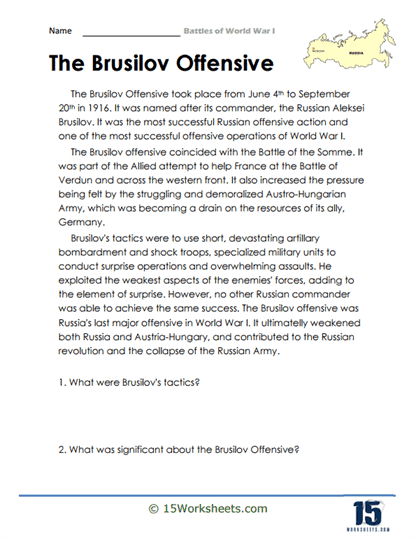Brusilov Offensive

Worksheet Description
This worksheet centers on the Brusilov Offensive, a critical military campaign during World War I that transpired from June 4th to September 20th in 1916. Named after its orchestrator, Russian commander Aleksei Brusilov, this offensive is touted as one of the most successful Russian military maneuvers during the war. The operation was strategically timed to alleviate pressure on France at the Battle of Verdun and the Western front. Concurrently, it exacerbated the challenges faced by the beleaguered Austro-Hungarian Army, which was already grappling with resource constraints and demoralization, indirectly pressuring Germany, its ally.
To adeptly tackle this worksheet, students should start by immersing themselves in the provided narrative, capturing the sequence, strategies, and broader context of the Brusilov Offensive within World War I’s landscape. Attention should be paid to the specific tactics employed by Brusilov, the intended and actual outcomes of the offensive, and its wider ramifications on other fronts and nations. Upon gaining a holistic understanding of the text, students are then poised to answer the worksheet’s questions, ensuring they reference the passage for well-grounded responses. Recognizing the interplay between individual battles, tactics, and the overarching war dynamics will be instrumental in grasping the complete picture.
This worksheet is designed to offer students a detailed glimpse into one of the pivotal operations during World War I, the Brusilov Offensive. Through a close reading, learners are exposed to the military strategies employed, the context in which decisions were made, and the broader implications of this campaign on the war’s trajectory. By presenting both the tactical genius of Brusilov and the consequences of the offensive, the worksheet aims to instill a nuanced understanding of warfare dynamics and the cascading effects of individual campaigns. In essence, it aspires to cultivate students’ analytical acumen, foster historical insight, and enable them to discern the multifaceted impacts of significant military endeavors.
